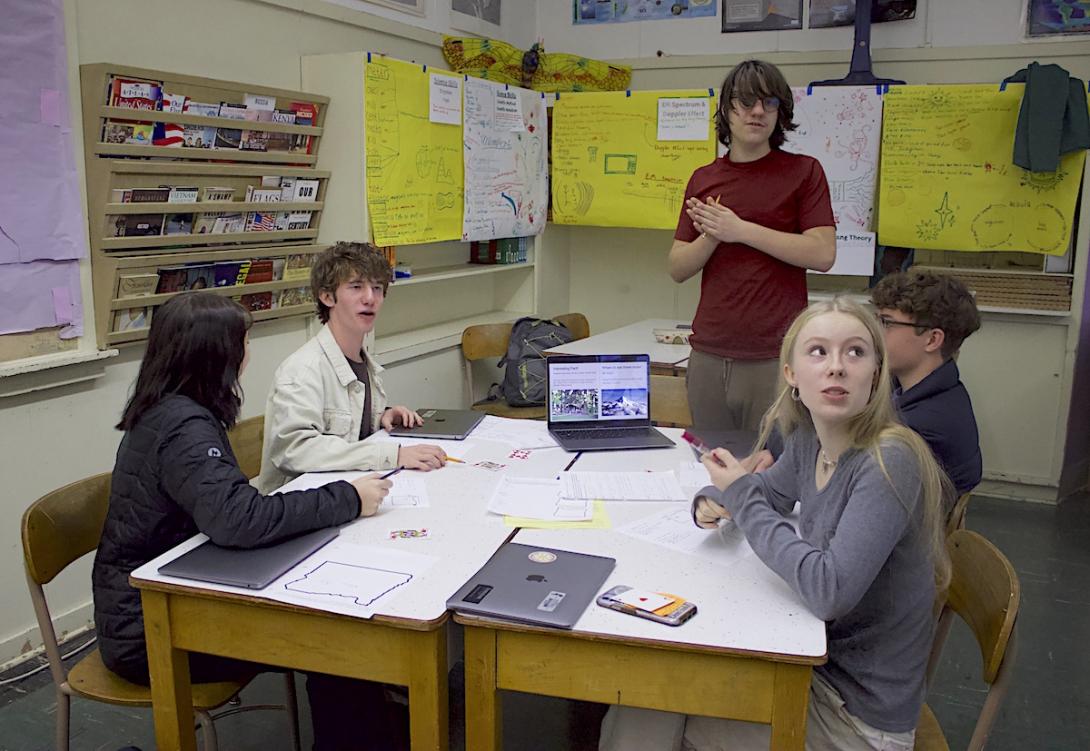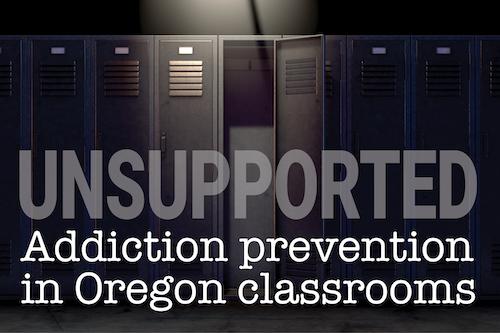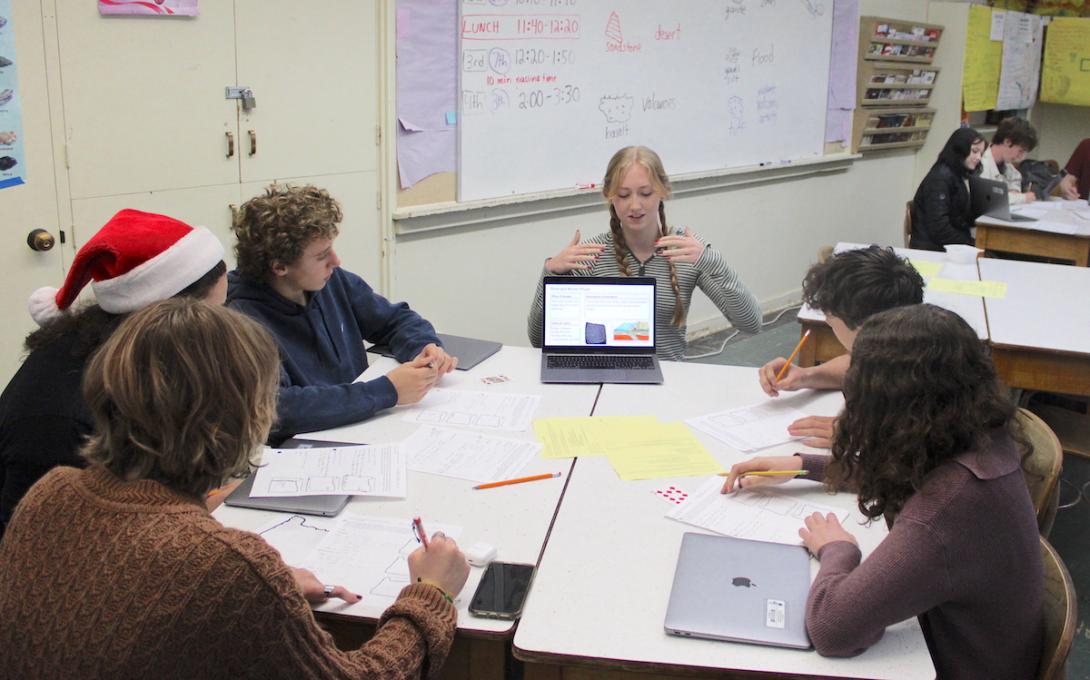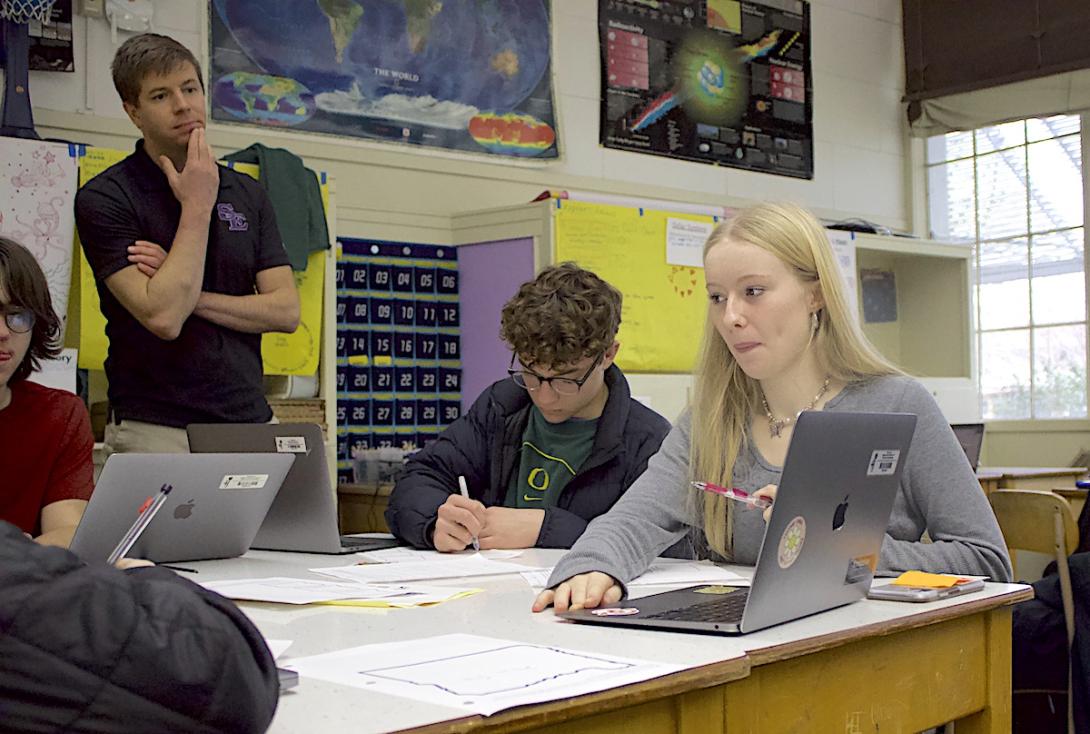
Sophomores in a science class at South Eugene High School aren’t learning about alcohol — but as they shuffle among tables, what they’re doing might indirectly reduce drinking problems later in life.

This article is part of an investigative series showing that as Oregon kids face a world with increasingly dangerous drugs and unparalleled external pressures, the state’s education establishment has failed to adapt.
They’re participating in what’s known as “cooperative learning.” It’s a teaching method in which students spend time working together in randomly selected groups. As they teach each other, it promotes interaction among kids who otherwise wouldn’t socialize, combating peer rejection. . In a trial across 15 middle schools, cooperative learning lowered rates of alcohol use and other risk factors that contribute to substance use, such as emotional problems, bullying, deviant peer affiliation and more.
Following that Oregon-based study, cooperative learning was recently listed among approaches to reducing substance use problems that experts say have good scientific evidence to back them.
Oregon’s position is “ironic,” said Anthony Biglan, a senior scientist at Oregon Research Institute who studies youth prevention. Oregon is “one of the strongest states” in terms of research on school-based prevention, he said, but isn’t putting what it knows into practice. Cooperative learning, for example, is used by some individual teachers, but has yet to be adopted across any district.
Other states do more when it comes to connecting classroom substance use prevention with science.
A recent investigation found that in Oregon, most school districts teach substance use prevention curricula and programs that have not been found to meet even the minimum standard of efficacy set by some of the nation’s top prevention and curricula clearinghouses. That’s despite a state law requiring districts to have an up-to-date, comprehensive, science-backed program. And the state does little to help them.
Biglan and other prevention experts point to Washington, Colorado and Pennsylvania, where the state governments have formed partnerships with prevention scientists at local universities to roll out evidence-backed prevention strategies across the state.
Now, a new set of recommendations from Oregon’s Alcohol and Drug Policy Commission is urging state lawmakers to launch a similar effort as they head into the 2024 legislative short session next month.
Other states put science at the center of prevention
In Washington and Pennsylvania, state officials work with prevention scientists at local universities to ensure state programs support evidence-based prevention strategies at the community level. In both states, schools and communities can get state grants to pay for prevention if they select from a predetermined list of evidence-backed programs to adopt.
In Pennsylvania, much of the state’s prevention work flows through the Pennsylvania Commission on Crime and Delinquency, which works closely with the Evidence-based Prevention and Intervention Support center, or EPIS, at Pennsylvania State University. There, principal investigator Janet Welsh and her colleagues have helped implement evidence-based programs in communities and schools that studies indicate led to reductions in delinquency rates and fatal opioid overdoses.
The state has also championed several programs aimed at reducing youth substance use, Welsh said. That includes funding community coalitions, and rolling out a well-regarded national community-based model called PROSPER, which was developed at Pennsylvania State University. It brings together prevention coordinators and universities to deliver two evidence-backed interventions in schools: LifeSkills Training and Strengthening Families. It’s had positive results.
In Pennsylvania, when communities or schools use state grants to implement programs, they are required to apply evidence-supported approaches as they were designed and track their outcomes, Welsh told The Lund Report.
“There are people off in silos doing their own things in Pennsylvania, just like there are anywhere else,” Welsh said. “But we try really hard to have these coordinated systems to the degree that we can.”
In Washington, the health authority’s behavioral health division oversees and coordinates prevention efforts in the state, working with a committee of researchers, policymakers and community-based advocates to incorporate science in a statewide approach. Every three months, the group convenes to discuss pressing issues, potential approaches and the latest research, said the subcommittee’s chair, Brittany Cooper. Cooper is a principal investigator at Washington State University’s Improving Prevention through Action (IMPACT) research lab.
Cooper and her colleagues at the lab regularly look at evidence to review prevention programs and strategies before recommending them to the state. The state also looks to the Washington Institute for Public Policy for guidance on the cost-benefit of different research-backed programs. Strong programs are added to the state’s list of approved prevention strategies that communities pick from when doing state-funded prevention work.
Both states’ approaches place a major focus on community coalitions that bring together schools, law enforcement, public health officials and local groups.
Washington has more than 100 such coalitions, and Pennsylvania has trained more than 125 on the model, known as “Communities that Care.” In Oregon, health authority officials were not able to supply The Lund Report with a complete list of community coalitions.
In both Washington and Pennsylvania, the departments of education are an integral part of prevention coordination, unlike in Oregon.
State could spread promising approaches
On the December morning that The Lund Report visited the South Eugene High School classroom, Zach Lazar’s students were learning about Oregon’s geological history. They were separated into small groups, with each group learning about a different phase of the state’s formation. The kids had to work together to make a group presentation in Google Slides. Next, Lazar walked around the room handing out playing cards, and the sophomores regrouped according to the suit of the card they were handed. Now each student had to teach their new group what they had learned.

For Lazar, it’s a way to ensure kids are paying attention. “It allows everybody to be active and present in the space — and that’s huge,” he said. “You can’t hide when you’re going to be expected to teach someone else in a few minutes. You’ve got to get your stuff done.”
Cooperative learning also encourages students to interact with students they might not normally talk to. The idea is this breaks down biases and prejudices among students that serve as barriers to social connection, and helps socially isolated students establish positive relationships with their peers.
Mark Van Ryzin, a research professor at the University of Oregon, led a study of cooperative learning involving 1,890 middle school students in Oregon that documented the program’s positive benefits. The study found cooperative learning-involved students experienced lower rates of alcohol use, emotional problems, deviant peer affiliation and bullying, as well as higher rates of prosocial behavior, emotional empathy and close relationships with peers. The clearinghouse Blueprints for Health Youth Development, which rigorously evaluates the research behind prevention programs, certified Van Ryzin’s study for its scientific strength and listed cooperative learning on its registry of recommended “promising” interventions.
Van Ryzin said the types of benefits achieved through cooperative learning are key in substance use prevention. “The best approach is to attack the social-contextual issues that lead to experimentation with drugs, but very few programs do this successfully,” he said.

After class, a couple of Lazar’s students told The Lund Report that they had indeed made friends with people they may not have otherwise talked to when learning this way in science class. They also said that Lazar was the only teacher they’d ever had who uses this style of teaching.
Creating groups and moving kids around can take extra time that teachers don’t have. But Van Ryzin thinks an app he’s developed could be used more widely to help more teachers around the state. It creates random student groupings as it moves a class through a pre-loaded curriculum.
He said one opportunity he sees is with high schools’ recent effort to adopt curricula to help ninth graders build skills to succeed in high school.
“Schools have told me, they just pull things off the internet, nobody has any idea if any of this works,” Van Ryzin said.
In contrast, software loaded with this curriculum and backed by a central state program could embed these lessons in classrooms while also spreading the benefits of cooperative learning.
“We could potentially kill two birds with one stone,” he said. “So we’re building peer relations, building social skills, building belonging, keeping students on track, keeping them in school — why couldn’t we solve all these problems at once?”
Where Oregon stands
The state’s Alcohol and Drug Policy Commission, which is charged with improving Oregon’s state and local addiction treatment, prevention and recovery systems, sent its legislative recommendations to Gov. Tina Kotek and state Senate and House majority and minority leaders on Dec. 11. At the top of its list was a request to fund “a statewide hub for Substance Use Prevention.”
Biglan, who has studied youth prevention for more than three decades, sits on the commission’s prevention subcommittee. He said he hopes there is a “significant representation of prevention scientists” if the hub is approved. He said state agencies including the education department should also be involved, along with Oregon’s regional coordinated care organizations that oversee care delivered to low-income members of the Oregon Health Plan.
“I’m concerned that there’s not enough involvement of the Department of Education,” he said, adding that the department seems to lack the authority and programmatic support “to influence the schools to do things.”
At the University of Oregon’s Prevention Science Institute, research scientist Emily Tanner-Smith said prevention scientists would “be excited” to partner with the state. “UO researchers have deep expertise in school- and community-based prevention programming and thus would be well-poised to engage in such activities,” she said.
In Oregon, “we don’t have comprehensive prevention” anywhere, said Annaliese Dolph, a former aide to Gov. Tina Kotek who took over as director of the state Alcohol and Drug Policy Commission last year. Connecting research and practices will be a “key role” for the commission she said, adding that if lawmakers set up the recommended statewide hub, prevention scientists would “absolutely” play an integral role.